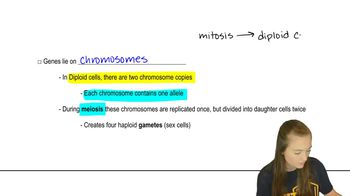Nuclei from almost any source may be injected into Xenopus oocytes. Studies have shown that these nuclei remain active in transcription and translation. How can such an experimental system be useful in developmental genetic studies?
Table of contents
- 1. Introduction to Genetics51m
- 2. Mendel's Laws of Inheritance3h 37m
- 3. Extensions to Mendelian Inheritance2h 41m
- 4. Genetic Mapping and Linkage2h 28m
- 5. Genetics of Bacteria and Viruses1h 21m
- 6. Chromosomal Variation1h 48m
- 7. DNA and Chromosome Structure56m
- 8. DNA Replication1h 10m
- 9. Mitosis and Meiosis1h 34m
- 10. Transcription1h 0m
- 11. Translation58m
- 12. Gene Regulation in Prokaryotes1h 19m
- 13. Gene Regulation in Eukaryotes44m
- 14. Genetic Control of Development44m
- 15. Genomes and Genomics1h 50m
- 16. Transposable Elements47m
- 17. Mutation, Repair, and Recombination1h 6m
- 18. Molecular Genetic Tools19m
- 19. Cancer Genetics29m
- 20. Quantitative Genetics1h 26m
- 21. Population Genetics50m
- 22. Evolutionary Genetics29m
14. Genetic Control of Development
Early Developmental Steps
Problem 10b
Textbook Question
Ablation of the anchor cell in wild-type C. elegans results in a vulva-less phenotype.
What about if the anchor cell is ablated in a let-23 gain-of-function mutant?
 Verified step by step guidance
Verified step by step guidance1
Understand the biological context: The anchor cell in *C. elegans* plays a critical role in vulval development by signaling to the underlying vulval precursor cells (VPCs) through the LET-23 receptor tyrosine kinase pathway. Ablation of the anchor cell in wild-type worms results in a vulva-less phenotype because the VPCs do not receive the necessary signal to differentiate.
Review the let-23 gain-of-function mutation: A gain-of-function mutation in the let-23 gene leads to constitutive activation of the LET-23 receptor, meaning the receptor is active even in the absence of the anchor cell signal. This can result in inappropriate or excessive signaling to the VPCs.
Analyze the experimental scenario: If the anchor cell is ablated in a let-23 gain-of-function mutant, the VPCs will not receive the normal inductive signal from the anchor cell. However, due to the gain-of-function mutation, the LET-23 receptor may still be active, potentially leading to vulval development even in the absence of the anchor cell.
Predict the outcome: Consider the role of the gain-of-function mutation in bypassing the need for the anchor cell signal. The VPCs may still differentiate into vulval cells because the LET-23 receptor is constitutively active, mimicking the effect of the anchor cell signal.
Conclude the reasoning: The phenotype in this scenario is likely to differ from the wild-type ablation case. Instead of a vulva-less phenotype, the let-23 gain-of-function mutant may still develop a vulva, demonstrating the impact of the constitutively active LET-23 receptor on vulval development.
 Verified video answer for a similar problem:
Verified video answer for a similar problem:This video solution was recommended by our tutors as helpful for the problem above
Video duration:
4mPlay a video:
Was this helpful?
Key Concepts
Here are the essential concepts you must grasp in order to answer the question correctly.
Anchor Cell Function
In C. elegans, the anchor cell is crucial for vulval development as it signals to surrounding cells to induce vulva formation. This signaling is mediated through the LIN-3 growth factor, which activates the LET-23 receptor in adjacent cells, leading to the differentiation of vulval precursor cells.
Recommended video:
Guided course

Functional Genomics
LET-23 Receptor
LET-23 is a receptor tyrosine kinase that plays a vital role in the vulval development pathway in C. elegans. In a gain-of-function mutant, LET-23 is constitutively active, which can lead to abnormal signaling and potentially alter the normal developmental processes, including those initiated by the anchor cell.
Recommended video:
Guided course

Diploid Genetics
Gain-of-Function Mutations
Gain-of-function mutations result in a gene product that has increased activity or a new function. In the context of the let-23 mutant, this means that the receptor is always active, which can lead to excessive or inappropriate vulval cell signaling, potentially compensating for the absence of the anchor cell and affecting the vulval phenotype.
Recommended video:
Guided course

Functional Genomics

 3:46m
3:46mWatch next
Master Drosophilia Development with a bite sized video explanation from Kylia
Start learningRelated Videos
Related Practice
Textbook Question
390
views
